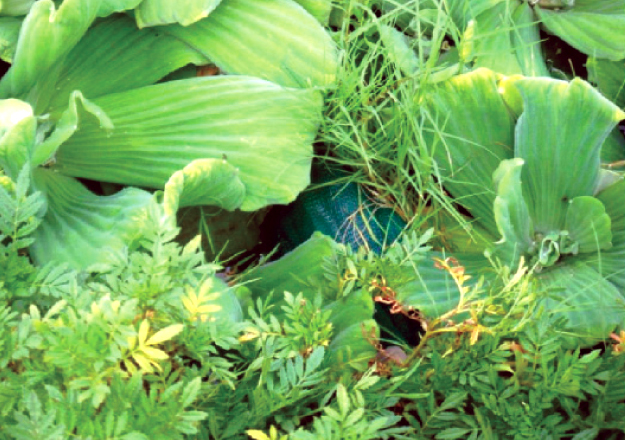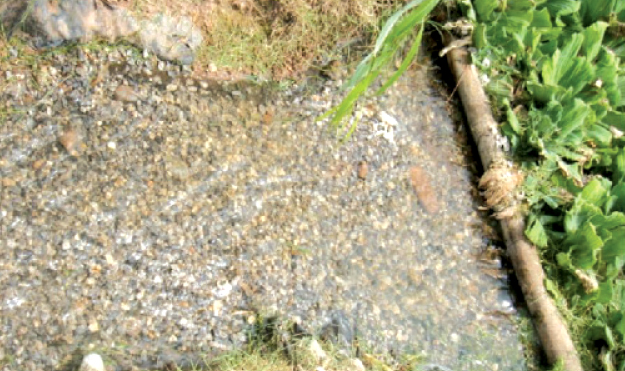A subcommittee of the River Ravi Commission, which is tasked with finding a way to clean up the watercourse, has suggested that a bioremediation project based on constructed wetlands be built in Lahore.
On December 7, the Lahore High Court’s Green Bench directed the commission to publish the subcommittee’s report on indigenous wastewater technologies on the websites of the World Wide Fund for Nature Pakistan (WWF-P), the LHC, the Environment Protection Department (EPD) and the Water and Sanitation Agency (Wasa), so members of the public could comment on it before the next hearing due on January 13. The report has not been published on the websites, but a copy has been obtained by The Express Tribune.
Members of the subcommittee visited two bioremediation sites in Islamabad and waste stabilisation ponds in Faisalabad in August to assess which was a better way to treat wastewater.
They found the Bioremediation Garden and Bioremediation Orchard in Islamabad to be the most efficient and cost-effective at treating wastewater and suggested that a 50-acre site be set up at Babu Sabu for the treatment of 10 cusecs to demonstrate its use.
Analysis of the treated water from the plants in Islamabad showed that at the former sites, the biochemical oxygen demand (BOD) and chemical oxygen demand (COD) had been reduced by 83 per cent and 86 per cent respectively (BOD and COD are measures of pollution in water), bringing the quality of water in line with the National Environmental Quality Standards.
Meanwhile, the waste stabilisation ponds reduced the BOD and COD by 55 per cent and 53 per cent, leaving the treated water still unfit for the purposes of irrigation. They also take up more space than the bioremediation sites.
The 50-acre pilot site at Babu Sabu, if it is built, would cost around Rs42.65 million to build and clean 10 cusecs of water. Lahore currently produces 1,800 cusecs of wastewater a day.
River Ravi Commission Chairman Dr Kausar Abduallah Malik welcomed the LHC’s direction to publish the report. “How many public hearings does one see actually benefit a project of public interest, such as a new highway or flyover? Suggestions from members of the public are welcome and may help improve the project. It is a basic procedure with all big projects in the democracies of the world,” he said.

Malik said that if the pilot project is successful, more artificial wetlands could be built along the banks of the Ravi. He said that the sites did not require a lot of technology, was cost-effective, and could even bring in revenue in the form of eco-tourism.

Dr Ejaz Ahmad of WWF-Pakistan, who was part of the subcommittee, said that bioremediation sites were more suited to Lahore than Islamabad. “The duration of the optimum temperature for functioning of microbes in a bioremediation pond is longer in Lahore than in Islamabad, which may make it more effective for Lahore,” he said.
Ahmad said if work on the bioremediation site at Babu Sabu started in February, it would start functioning in three to six months. However, the site would not fully mature for two to three years, he said.
River Ravi Commission coordinator Sohail Ali Naqvi said if the LHC approved the project, the commission would ask the National Agricultural Research Centre, which is in charge of the Bioremediation Garden and Bioremediation Orchard in Islamabad, to provide consultation services. Wasa, said Naqvi, had already agreed to provide the land for the pilot plant.

The commission has also formed a review committee to conduct a technical examination of a feasibility report, being prepared by Wasa and the Japanese International Cooperation Agency (JICA), for the establishment of waste stabilisation ponds at Mehmood Booti. He said the RRC was also preparing for a seminar on the topic of converting waste into energy. The possibility of land formerly reserved for a wastewater treatment plant, which was to be built with French assistance, being used instead for more bioremediation sites was also being discussed.
Treating wastewater
Bioremediation is the use of micro-organism metabolism, plants and enzymes to remove pollutants from water.

Constructed wetlands are man-made wetlands used to remove various types of pollutants present in wastewater. They are constructed to recreate the structure and functions of natural wetlands. They possess a rich microbial community to effect the biochemical transformation of pollutants; they are biologically productive and self-sustaining.
Stabilisation ponds consist of shallow man-made basins comprising a single or several series of anaerobic, facultative or maturation ponds. The primary treatment takes place in the anaerobic pond, which is mainly designed for removing suspended solids, and some of the soluble element of organic matter (BOD). In the facultative pond, most of the remaining BOD is removed through the coordinated activity of algae and heterotrophic bacteria.
*These definitions are taken from the report of the subcommittee of the River Ravi Commission.
Published in The Express Tribune, December 12th, 2012.
COMMENTS (6)
Comments are moderated and generally will be posted if they are on-topic and not abusive.
For more information, please see our Comments FAQ
1723032398-0/BeFunky-collage-(36)1723032398-0-405x300.webp)

1732569774-0/Baymax-(2)1732569774-0-165x106.webp)














Sir i think that you are doing the correct thing and appreciate your efforts, of the record. I had send an application to the Chief Justice of the Supreme Court with a copy to Sindhi Chief Minister and the Governor some time back regarding Rallies and gathering at the Quaids Mazar in Karachi the Religious Parties and others, to be Banned as its a Maine Road and have Problems for the traffic, which causes a a traffic jam every where, but have received no response till date. Would appreciate if your organization could take some action in this regard. Thank you Regards Yusuf Alavi
@Hammad:
I think they are talking to use this water for agriculture not for drinking. Should there be concern even in doing that ? As we are already using all those metals in pesticides ?
@Blithe: plz be logical......this bioremidiation technique could reduce the BOD and COD levels but what about the other dangerous chemical parameters like arsenic, chromium, mercury, etc....??? they can't be treated through this process. There are 32 parameters in NEQS. We just jump into conclusions so early and try to implement n execute technologies without planing the future outcomes.
What a fool criteria to compare WSPs with Wetlands???? The commission is comparing the newly constructed wetlands in Islamabad efficiency with a WSPs which were constructed in 1997-98 in Faisalabad efficiency is that logical?? Dr. Kausar is a biologist and always thinks of the fact thats plants treatment will be great but the fact is not in favour.The Waste Stabilization Ponds which were commissioned in 1997-98 in faisalabad have still treating the effluent more efficiently without and major O&M, and one thing more is that these ponds are not de-sludged from the day it commissioned.
Its time to incorporate additional Rupees in the Lahore residents property taxes. In order to make available the concept of blowing compressed air thru sewage which will increase treated sewage to BOD levels beyond 90% that can safely be disposed off without any further environmental damage. This is a necessity that is long overdue.
Some sensible green planning .
This must be forced on to Shahbaz Sharif , who shows very little regard for the environment .